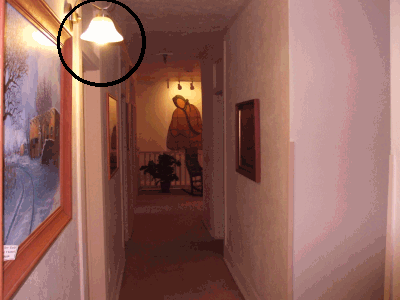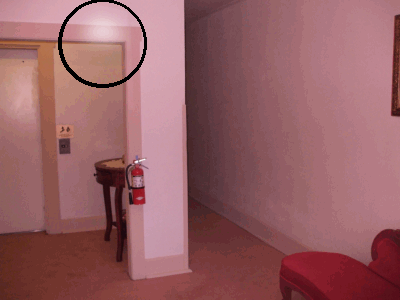Full-spectrum photography is a subset of full spectral imaging, defined currently among photography enthusiasts as imaging with consumer cameras the full, broad spectrum of a film or camera sensor bandwidth. In practice, a specialized broadband/full-spectrum camera captures visible, near infrared and near ultraviolet light. For a camera to be full spectrum, it must be able to capture all three. However, the majority of the “Full Spectrum” cameras sold by paranormal and ghost hunting oriented stores are not actually full spectrum. So I’m going to explain why they are not, the issues involved with full spectrum photography and some helpful tips if you seriously want to explore this.
The first step in modifying a digital camera to a full spectrum camera is to remove the IR cut filter/ Hot mirror and replace it with a piece of optical quality glass (in optics it is called an uncoated window). This glass has various spectral properties. Typical glass types used include Schott WG-280 and BK-7, which transmit as much as 90% from around 300nm to past 1000nm. Average quality glass (like those found in the windows of your house) will not work. The optical qualities of the glass reflect UV light, thus preventing it from entering the image sensor. You may have noticed this effect when you are walking by the front of a supermarket and you can see your reflection in the glass. It’s reflected UV light.
This is where the first problem lies, particularly in the inexpensive “Full Spectrum” cameras. To keep costs down, they use cheap, clear glass which prevents some of the UV light from entering. So it is not actually a full spectrum camera.
But wait…it gets worse.
In the consumer grade camera, infrared light is dealt with by the IR cut filter/hot mirror. They deal with the ultraviolet light by applying a UV reduction coating(s) on lens. The purpose of this is to create an image that will be similar to what the human eye sees. This is what the consumers want in a camera. Removing it ruins the camera for photographing the visible spectrum. There is also a reduction in signal which requires longer exposure times (up to 20 seconds). If the dealer has not removed the lens coating, it is not a full spectrum camera.
*******Dupe Alert*******
Visible light has wavelength in a range from about 380 nm to about 740 nm. Ultraviolet A (long wave or black light) enters the visible spectrum up to 400nm. Since the camera manufacturers want visible light to pass to the image sensor, Ultraviolet A makes it to the sensor too.
Many of the websites selling “Full Spectrum” cameras to paranormal investigators go through great pains to demonstrate that their cameras pick up UV light and indeed they do, technically, but that is a far cry from true Full spectrum. You can do the exact same thing with an unmodified camera by simply screwing on a visible light cut filter (also called a visible bandpass filter) and adding a UV light source. Ta-Da!
I’m not saying that the stores that sell these cheap ass “full spectrum” cameras are out to rip you off. I think it is more an issue of ignorance and misinformation about what they are creating. They are not optics technicians.
More issues about modified (Full Spectrum) Cameras that you need to know about!
If I had a nickel for every time someone asked me why their brand new full spectrum camera takes video and photos that are often out of focus I could buy a beer or two. The short and sweet answer is that they bought a crappy camera or the modification was done incorrectly. The more technical answer is that IR light is longer in wavelength than visible light and focuses differently. Regular photographic lenses are made for visible light photography without any regard to what happens when photographing “out of band” light like IR and UV. Many of the people who modify digital cameras are unaware of this. Either they simply don’t deal with it or they lock the focus on infinity. Regardless, it means that they don’t know dick about how to properly convert the camera to full spectrum.
Another important factor is that you use a good optical platform (a decent camera with good optics). If you are paying under $300 for a Full Spectrum camera, it has crappy optics. More than likely the optics were mass produced in Taiwan or China to very basic specs and are the major cause of artifacts in your photos that are often mistaken for ghosts by amateurs.
Good optics and hardware are everything and play a major role in selecting a camera to modify. To do this you have to get the spectral chart for the type of image processor (CCD, CMOS). Look for a good curve in the spectrum that you are interested in studying. For example the Fujifilm FinePix S3 Pro UVIR, Super CCD SRII sensor, the UVIR is photosensitive to wavelengths from approximately 350nm-1000nm. This is the max that camera can pick up. No more, no less. So choose wisely.
Crappy optics combined with a poor modification can create photographic artifacts that are often interpreted as paranormal activity or ghosts. A combination of poor focus, improper modifications, low temperatures and high ISO settings can cause a CCD residual charge. What ISO denotes is how sensitive the image sensor is to the amount of light present. The higher the ISO, the more sensitive the image sensor and therefore the possibility to take pictures in low-light situations. I also believe there are some other factors involved but at the moment, I’m not exactly sure what they are. I have noticed that the cheaper cameras are more prone to create artifacts when the power is getting low and there is a rate of high usage. Replicating a photo containing artifacts, even with the same camera and lighting conditions can be difficult as well. This has probably contributed to the belief that cheaper optics (cameras) are capable of recording paranormal activity.
The CCD residual charge is created when electrons are trapped on the image processor (over saturation) and a “ghost” image (that is literally what it is called) of the over saturated pixels appear in the next photograph. The effect often looks like translucent mists (ECTOPLASM!) but can be any size or shape, depending on how many pixels were affected. Residual charges can last up to thirty seconds before the pixels balance back out to normal. CCD image sensors are more prone to this than CMOS image sensors.
Another artifact can be created by a phenomenon called Dark Current. Dark current arises from thermal energy within the silicon lattice of the CCD. Electrons are created over times that are independent of the light falling on the detector. These electrons are captured by the CCD and counted as signal. To minimize dark current scienctific CCDs are usually cooled.
The bottom line is that if you wish to experiment with full spectrum photography, it is best to save your money and buy a camera with good optics. Then have the camera modified by a professional who knows what they are doing. A company that I recommend is http://www.lifepixel.com/.

